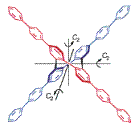Chemistry, Department of: Faculty Series

Andrzej Rajca Publications
Document Type
Article
Date of this Version
2006
Citation
J Am Chem Soc. 2006 October 18; 128(41): 13497–13507.
Abstract
Calix[4]arenes constrained to 1,3-alternate conformation and functionalized at the upper rim with
four and two tert-butylnitroxides have been synthesized, and characterized by X-ray crystallography,
magnetic resonance (EPR and 1H NMR) spectroscopy, and magnetic studies. The 1,3-alternate
nitroxide tetraradical and diradical provide unique polyradical scaffolds for dissection of the throughbond
and through-space intramolecular exchange couplings. In addition, detailed magnetic studies
of the previously reported calix[4]arene nitroxide tetraradical, which possesses cone conformation
in solution, reveal conformational dependence of exchange coupling. Through-bond coupling
between the adjacent nitroxide radicals is mediated by the nitroxide-m-phenylene-CH2-m-phenylenenitroxide coupling pathway, and through-space coupling is found between the diagonal nitroxide radicals at the conformationally-constrained N···N distance of 5–6 Å. Magnetic studies of the calix[4]arene polyradical scaffolds in frozen solutions show that the through-bond exchange coupling in
the 1,3-alternate calix[4]arene tetraradical is antiferromagnetic, while that in cone calix[4]arene
tetraradical is ferromagnetic. The through-space exchange couplings are antiferromagnetic in both
cone and 1,3-alternate calix[4]arene tetraradical, as well as in the 1,3-alternate calix[4]arene
diradical. The exchange coupling constants (|J/k|) are of the order of 1 Kelvin.


Comments
Copyright 2006 Rajca et al.